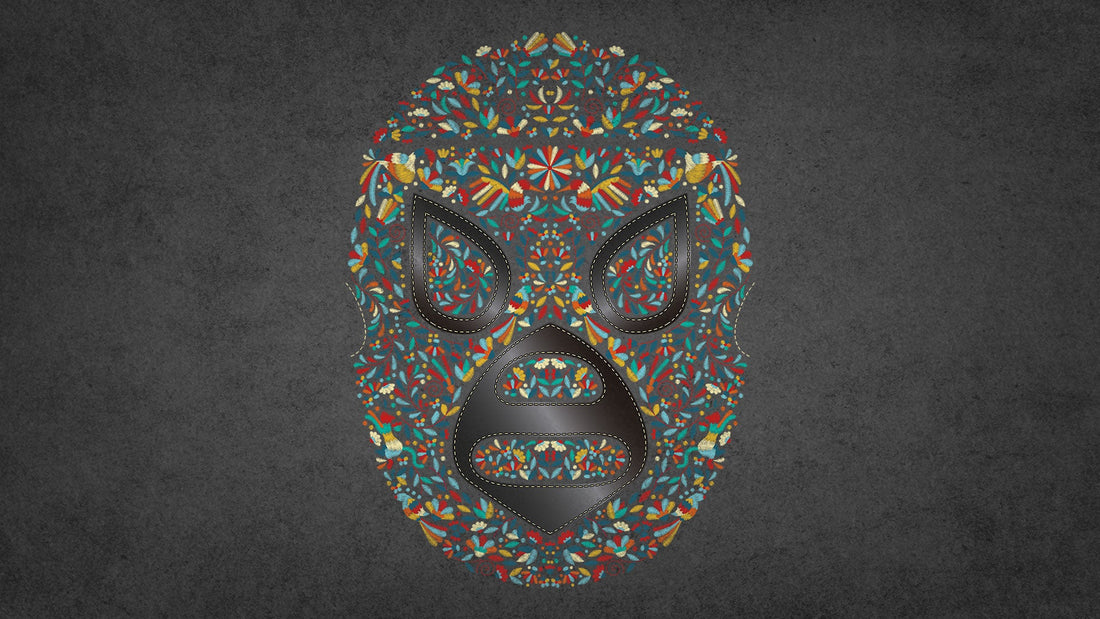The Legend of the Otomi Fighter: The Warrior of Balance and Tradition

Share
In the lands of the Otomí-Tepehua Mountains, where the mountains meet the clouds and legends intertwine with reality, the figure of the Otomí Luchador emerges, a mystical warrior who represents power, tradition, and balance. This wrestler is known not only for his strength and skill in the ring, but also for his deep respect for his cultural roots and his ability to maintain harmony between the ancient and modern worlds.
The design of the Otomi Wrestler is a spectacle of color and symbolism. His richly detailed mask is inspired by traditional Otomi patterns, with intricate embroidery evoking the artistry and spirituality of his people. The mask's vibrant colors, which include shades of red, black, and gold, highlight not only his bravery but also his connection to sacred elements and natural forces. The mask's embellishments include symbols representing earth, sky, and fire—vital elements in the Otomi worldview.
The Otomi wrestler's costume is adorned with traditional elements such as feathers and amulets, symbolizing his connection to nature and his ancestors. Each piece of his attire is carefully crafted to reflect the richness of Otomi culture, from the geometric patterns that adorn his costume to the details of his cape, which waves like a banner in the ring.
The legend of the Otomí Wrestler tells of his emergence at a time when traditions and modern ways of life were in conflict. The youth of his community were straying from their roots, and the balance between past and present seemed threatened. In response, the Otomí Wrestler emerged as a symbol of unity, uniting physical strength with cultural respect.
During matches, he not only demonstrates his wrestling skills but also uses his platform to share stories and lessons from Otomi culture. Every move and technique in the ring has a deeper purpose, conveying lessons about the importance of identity, community, and preserving tradition.
One of the most iconic stories about the Otomí wrestler is that of his performance in a national wrestling tournament. Despite the difficulties and rivalries, his performance in the ring not only won the admiration of his opponents but also the respect of the spectators, who saw in him a living representation of the cultural richness and strength of his community. With each victory, the Otomí wrestler not only defended his title but also his heritage, proving that true strength lies in the unity between the past and the present.
The Otomi Wrestler is more than a combat figure; he's a symbol of resilience and cultural pride. His legacy lives on in every encounter, in every story told through his wrestling dance, and in the inspiration he provides to those seeking to keep their traditions alive while navigating the modern world.
Today, the image of the Otomi Wrestler remains a powerful reminder of the importance of maintaining a balance between strength and tradition. His presence in the ring is a celebration of Otomi culture and a tribute to the courage of those who fight not only for personal victories, but also for the preservation of their rich cultural heritage.
The design of the Otomi Wrestler is a spectacle of color and symbolism. His richly detailed mask is inspired by traditional Otomi patterns, with intricate embroidery evoking the artistry and spirituality of his people. The mask's vibrant colors, which include shades of red, black, and gold, highlight not only his bravery but also his connection to sacred elements and natural forces. The mask's embellishments include symbols representing earth, sky, and fire—vital elements in the Otomi worldview.
The Otomi wrestler's costume is adorned with traditional elements such as feathers and amulets, symbolizing his connection to nature and his ancestors. Each piece of his attire is carefully crafted to reflect the richness of Otomi culture, from the geometric patterns that adorn his costume to the details of his cape, which waves like a banner in the ring.
The legend of the Otomí Wrestler tells of his emergence at a time when traditions and modern ways of life were in conflict. The youth of his community were straying from their roots, and the balance between past and present seemed threatened. In response, the Otomí Wrestler emerged as a symbol of unity, uniting physical strength with cultural respect.
During matches, he not only demonstrates his wrestling skills but also uses his platform to share stories and lessons from Otomi culture. Every move and technique in the ring has a deeper purpose, conveying lessons about the importance of identity, community, and preserving tradition.
One of the most iconic stories about the Otomí wrestler is that of his performance in a national wrestling tournament. Despite the difficulties and rivalries, his performance in the ring not only won the admiration of his opponents but also the respect of the spectators, who saw in him a living representation of the cultural richness and strength of his community. With each victory, the Otomí wrestler not only defended his title but also his heritage, proving that true strength lies in the unity between the past and the present.
The Otomi Wrestler is more than a combat figure; he's a symbol of resilience and cultural pride. His legacy lives on in every encounter, in every story told through his wrestling dance, and in the inspiration he provides to those seeking to keep their traditions alive while navigating the modern world.
Today, the image of the Otomi Wrestler remains a powerful reminder of the importance of maintaining a balance between strength and tradition. His presence in the ring is a celebration of Otomi culture and a tribute to the courage of those who fight not only for personal victories, but also for the preservation of their rich cultural heritage.
